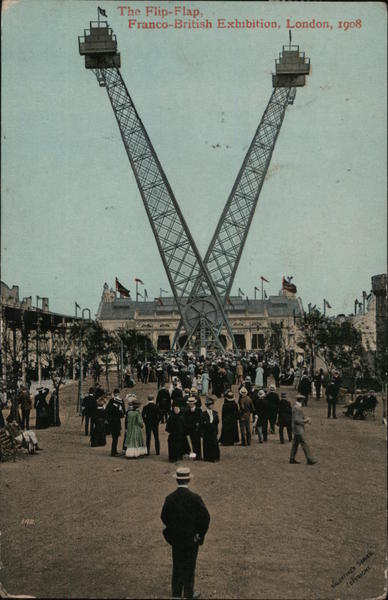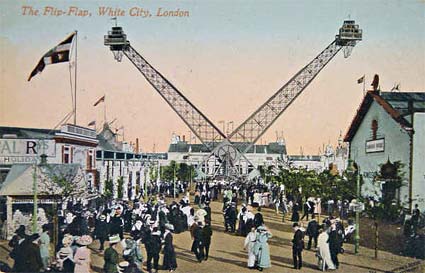When Doctors Disagree
Publication notes: First appeared in the December 1910 issue of The Strand Magazine. It was published in book form as part of The Man Upstairs collection in 1914 by Methuen & Co.
The first half of the story is set in the fictional Hotel Belvoir (pronounced ‘Beever’—and we might as well claim that Wodehouse named it for Belvoir Castle in Leicestershire; who's to stop us?). The latter half of the story is set in the White City area of London, near Shepherd’s Bush, at the time of the 1910 Japan/British Exhibition there, which ran from May to October.
- Welsh revival meetings
- ‘Farewell, Evelina, fairest of your sex.’
- on the Wiggle-Woggle
- the Hairy Ainus
- the Uji Village
- they moved slowly towards the Flip-Flap
The Welsh Christian revival lasted from 1904 to 1905, and is associated chiefly with Evan Roberts. Revival meetings were enough part of the British common memory for Wodehouse to reference them at least as late as 1923, with the publication of ‘The Exit of Battling Billson.’
In Frances Burney's 1778 novel, Evelina: Or The History of A Young Lady's Entrance into the World, Evelina records that Lord Orville writes her a note calling her ‘most charming of thy sex’ and, later, Sir Clement Willoughby addresses her as ‘Loveliest of thy sex.’
An amusement ride, as is reasonably obvious from context. A postcard from the Japan/British Exhibition at White City shows the Wiggle-Woggle to be an enormous incline. Two to four people climbed into a vehicle like an oversized bucket, and rode in that to the bottom, being buffeted along the descent by curved guide rails.

Wiggle Woggle, Japan-British Exhibition
[http://chindon.blogspot.ca/2010_06_01_archive.html]
Fans of the American television game show ‘The Price Is Right’ can picture the Wiggle-Woggle as a less jarring version of the prize game Plinko, with a much gentler incline, and guide rails instead of guide pegs. I make the American reference because it is possible the ride was imported from Coney Island in New York; there is a 1907 reference to the ride at http://www.100scooter.com/whohaveresearchedBrooklyntoth.htm
The Grey River Argus of 14 September 1911 noted on page 8 in an article titled ‘Eton and Harrow. Old Boys at the White City’ that ‘One elderly man insisted on going on the Wiggle-Woggle with his two sons seven consecutive times, and it was they who, shaked by so much “woggling,” persuaded him at last to desist.’ This elderly man is clearly a spiritual cousin of Arthur, who shares the same ‘light-hearted abandon on the Wiggle-Woggle,’ and it pleases me to think that the elderly man's pleasure might have won him the supreme accolade of the approval of Gally Threepwood and Uncle Fred (or to give him his full title, Frederick Altamont Cornwallis Twistleton, fifth Earl of Ickenham).
The Ainu are indigenous Japanese people. The men were noted among Japanese for their comparatively abundant facial and body hair. Representative members were on display as part of the Ainu home village at the 1910 Japan/British Exhibition at White City.
This village was part of the 1910 Japan/British Exhibition at White City. Today, Uji is a city on outskirts of Kyoto.
An amusement ride, as is (again) reasonably obvious from context. Norman Anderson’s 1992 book Ferris Wheels: An Illustrated History describes the Flip-Flap as being ‘a combination Ferris Wheel and tower.’ A 1908 postcard of Franco-British Exhibition at White City (two years before the story was published) shows the Flip-Flap to be a ride with two separate arms with large covered platforms.
Flip-Flap, Franco-British Exhibition, London, 1908
[https://www.cardcow.com/images/set951/card01090_fr.jpg]
These platforms lifted riders up and then down in a semi-circle, giving them views while at the top of the arc of Windsor Castle and Crystal Palace.
View from Flip Flap, Japan-British Exhibition, London, 1910
[http://chindon.blogspot.com/2010_06_01_archive.html]
The motion of the ride can be deduced from its name but a clearer idea of its path can be had by contrasting the position of the ride in a second image.The ride lasted three minutes and twenty seconds, and cost sixpence.
The Flip-Flap, White City, London
[http://www.urban75.org/railway/wood-lane-station.html]


